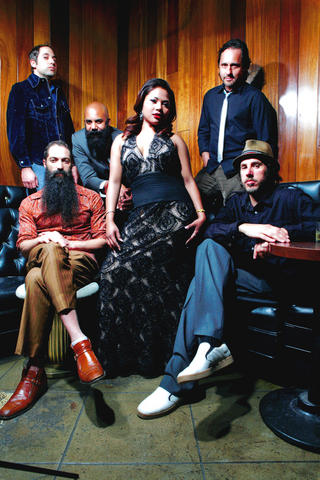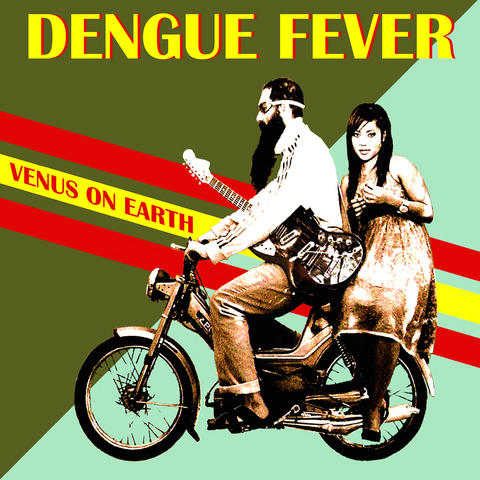Dengue fever is a Los Angeles band featuring a Cambodian-born singer and five American alt-rockers who regularly embarrass her onstage.
On the cover of its new album, Venus on Earth, the guitarist Zac Holtzman, with a long beard and goggles, drives a scooter with the vocalist Chhom Nimol sitting demurely behind him sidesaddle, the way a good Cambodian girl would ride through the streets of Phnom Penh. Dengue Fever, which specializes in an unlikely mix of 1960s Cambodian pop, rock and other genres, is a lot like that image. Propriety and smart aleck indie rock race by, blurring together.
It is a band of rollicking lightness that keeps coming up deep. At a recent show in the Echo Park neighborhood here, the male members were downright goofy, but Chhom, singing mostly in Khmer and dressed in shimmering Cambodian silk garments she designs herself, looked like old-school royalty, a queen before the hipoisie. No wonder she seemed to roll her eyes from time to time onstage. But after the set, when she lighted a candle onstage to honor those killed by the Khmer Rouge, her voice broke and tears ran down her face.

PHOTO COURTESY OF KEVIN ESTRADA
"I think we balance each other out," Holtzman said in a recent interview. "She'll bring the whole place to a hush, and that would be a long night if it was just that. And then we smash the place up."
Dengue Fever formed after the Farfisa organ player Ethan Holtzman, Zac's brother, traveled to Cambodia in 1997, discovered 1960s Cambodian pop and returned with a stack of cassettes. This was not the sort of roots-driven folk sounds ethnomusicologists crave; this was locally produced, gleefully garish trash infused with the surf guitar and soul arrangements that Armed Forces Radio blasted across the region during the Vietnam War. It flourished until the Khmer Rouge came to power in the 1970s and functionally dismantled Cambodian culture.
Dengue Fever's music is a tribute to that lost pop. But the six members of Dengue Fever form a quintessential Los Angeles crew, with a mix of backgrounds and interests that seems fitting in a region with the largest Cambodian population in the US (in Long Beach, south of downtown Los Angeles) and a flourishing indie rock scene (in the hills east of Hollywood). The band is the musical equivalent of that ultimate modern Los Angeles marker, the polyglot strip-mall sign. It too offers a cultural mash-up; beyond the obscure Cambodian pop you can hear psychedelia, spaghetti western guitars, the lounge groove of Ethiopian soul and Bollywood soundtracks. Seeing Hands, on the new album, has an almost Funkadelic groove, while Sober Driver is an all but emo complaint about a guy who drives the cute girl everywhere and gets nowhere.

PHOTO COURTESY OF KEVIN ESTRADA
Now Dengue Fever is starting to make its mark far from its hometown. The band recently returned from the Womex world music festival in Seville, Spain, where it was one of a handful of acts to play showcase performances. British publications have included it in "next big thing" roundups, and Dengue Fever's songs have been on television and film sound tracks, including Jim Jarmusch's Broken Flowers. A new documentary, Sleepwalking Through the Mekong, that follows the group on its first trip as a band to Cambodia, seems likely to gain it further notice.
"The underground people are getting hip to world music, and the world music side is getting hip to how you don't have to have a dreadlock wig and Guatemalan pants to be cool," said the bassist Senon Williams, sitting in his backyard with Chhom and Zac Holtzman.
"Now that Nimol is going to start singing more in English," he added, "it's making new things possible for us. Nimol really wants to connect with the American audience more now."
Dmitri Vietze, a publicist and marketer for many global music acts, sees the band as "part of a larger developmental pattern" in world music. "Can you stick them in the world-music bin at brick and mortar retail stores?" Vietze asked. "I don't know. But ... they are a part of a huge and promising future."
Older generations of Cambodians in California are sometimes critical. "They don't want me to show off too much of my dress," she said. "They always tell me, 'Don't forget you're a Cambodian girl.'" But the younger generation responds to Dengue Fever and even breakdances to its reinvention of a mongrel music that is itself a reinvention of a mongrel music from the West.
Folk music it's not, but in one crucial way Dengue Fever has folk resonances. To Chhom and other young Cambodians in the States, pop singers like Sinn Sisamouth and Ros Sereysothea, who died in a labor camp in Cambodia in the 1970s, hit a nerve that blues singers or hillbilly bands do for many Americans: the music takes listeners back home, to a home that doesn't precisely exist anymore.

Nov. 11 to Nov. 17 People may call Taipei a “living hell for pedestrians,” but back in the 1960s and 1970s, citizens were even discouraged from crossing major roads on foot. And there weren’t crosswalks or pedestrian signals at busy intersections. A 1978 editorial in the China Times (中國時報) reflected the government’s car-centric attitude: “Pedestrians too often risk their lives to compete with vehicles over road use instead of using an overpass. If they get hit by a car, who can they blame?” Taipei’s car traffic was growing exponentially during the 1960s, and along with it the frequency of accidents. The policy

Hourglass-shaped sex toys casually glide along a conveyor belt through an airy new store in Tokyo, the latest attempt by Japanese manufacturer Tenga to sell adult products without the shame that is often attached. At first glance it’s not even obvious that the sleek, colorful products on display are Japan’s favorite sex toys for men, but the store has drawn a stream of couples and tourists since opening this year. “Its openness surprised me,” said customer Masafumi Kawasaki, 45, “and made me a bit embarrassed that I’d had a ‘naughty’ image” of the company. I might have thought this was some kind

What first caught my eye when I entered the 921 Earthquake Museum was a yellow band running at an angle across the floor toward a pile of exposed soil. This marks the line where, in the early morning hours of Sept. 21, 1999, a massive magnitude 7.3 earthquake raised the earth over two meters along one side of the Chelungpu Fault (車籠埔斷層). The museum’s first gallery, named after this fault, takes visitors on a journey along its length, from the spot right in front of them, where the uplift is visible in the exposed soil, all the way to the farthest

The room glows vibrant pink, the floor flooded with hundreds of tiny pink marbles. As I approach the two chairs and a plush baroque sofa of matching fuchsia, what at first appears to be a scene of domestic bliss reveals itself to be anything but as gnarled metal nails and sharp spikes protrude from the cushions. An eerie cutout of a woman recoils into the armrest. This mixed-media installation captures generations of female anguish in Yun Suknam’s native South Korea, reflecting her observations and lived experience of the subjugated and serviceable housewife. The marbles are the mother’s sweat and tears,